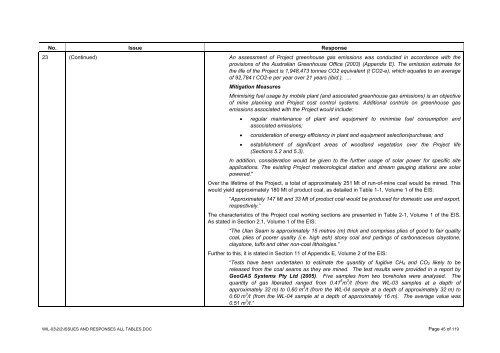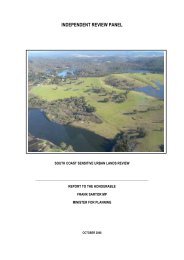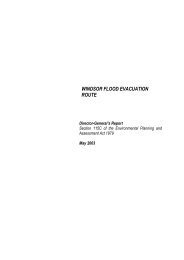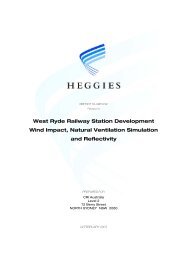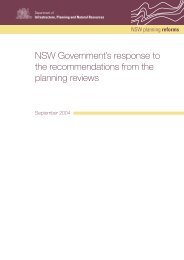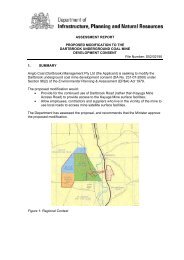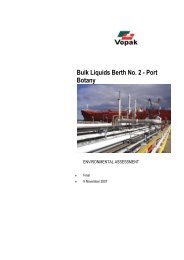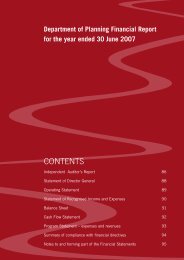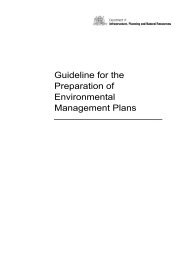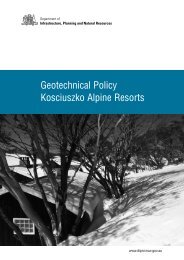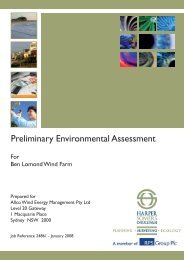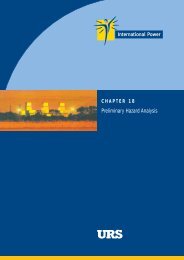wilpinjong coal project wilpinjong coal project - Department of ...
wilpinjong coal project wilpinjong coal project - Department of ...
wilpinjong coal project wilpinjong coal project - Department of ...
Create successful ePaper yourself
Turn your PDF publications into a flip-book with our unique Google optimized e-Paper software.
No. Issue Response<br />
23 (Continued) An assessment <strong>of</strong> Project greenhouse gas emissions was conducted in accordance with the<br />
provisions <strong>of</strong> the Australian Greenhouse Office (2003) (Appendix E). The emission estimate for<br />
the life <strong>of</strong> the Project is 1,948,473 tonnes CO2 equivalent (t CO2-e), which equates to an average<br />
<strong>of</strong> 92,784 t CO2-e per year over 21 years (ibid.). …<br />
Mitigation Measures<br />
Minimising fuel usage by mobile plant (and associated greenhouse gas emissions) is an objective<br />
<strong>of</strong> mine planning and Project cost control systems. Additional controls on greenhouse gas<br />
emissions associated with the Project would include:<br />
• regular maintenance <strong>of</strong> plant and equipment to minimise fuel consumption and<br />
associated emissions;<br />
• consideration <strong>of</strong> energy efficiency in plant and equipment selection/purchase; and<br />
• establishment <strong>of</strong> significant areas <strong>of</strong> woodland vegetation over the Project life<br />
(Sections 5.2 and 5.3).<br />
In addition, consideration would be given to the further usage <strong>of</strong> solar power for specific site<br />
applications. The existing Project meteorological station and stream gauging stations are solar<br />
powered."<br />
Over the lifetime <strong>of</strong> the Project, a total <strong>of</strong> approximately 251 Mt <strong>of</strong> run-<strong>of</strong>-mine <strong>coal</strong> would be mined. This<br />
would yield approximately 180 Mt <strong>of</strong> product <strong>coal</strong>, as detailed in Table 1-1, Volume 1 <strong>of</strong> the EIS:<br />
“Approximately 147 Mt and 33 Mt <strong>of</strong> product <strong>coal</strong> would be produced for domestic use and export,<br />
respectively.”<br />
The characteristics <strong>of</strong> the Project <strong>coal</strong> working sections are presented in Table 2-1, Volume 1 <strong>of</strong> the EIS.<br />
As stated in Section 2.1, Volume 1 <strong>of</strong> the EIS:<br />
“The Ulan Seam is approximately 15 metres (m) thick and comprises plies <strong>of</strong> good to fair quality<br />
<strong>coal</strong>, plies <strong>of</strong> poorer quality (i.e. high ash) stony <strong>coal</strong> and partings <strong>of</strong> carbonaceous claystone,<br />
claystone, tuffs and other non-<strong>coal</strong> lithologies.”<br />
Further to this, it is stated in Section 11 <strong>of</strong> Appendix E, Volume 2 <strong>of</strong> the EIS:<br />
“Tests have been undertaken to estimate the quantity <strong>of</strong> fugitive CH 4 and CO 2 likely to be<br />
released from the <strong>coal</strong> seams as they are mined. The test results were provided in a report by<br />
GeoGAS Systems Pty Ltd (2005). Five samples from two boreholes were analysed. The<br />
quantity <strong>of</strong> gas liberated ranged from 0.41 6 m 3 /t (from the WL-03 samples at a depth <strong>of</strong><br />
approximately 32 m) to 0.60 m 3 /t (from the WL-04 sample at a depth <strong>of</strong> approximately 32 m) to<br />
0.60 m 3 /t (from the WL-04 sample at a depth <strong>of</strong> approximately 16 m). The average value was<br />
0.51 m 3 /t.”<br />
WIL-03\2\2\ISSUES AND RESPONSES ALL TABLES.DOC Page 45 <strong>of</strong> 119


